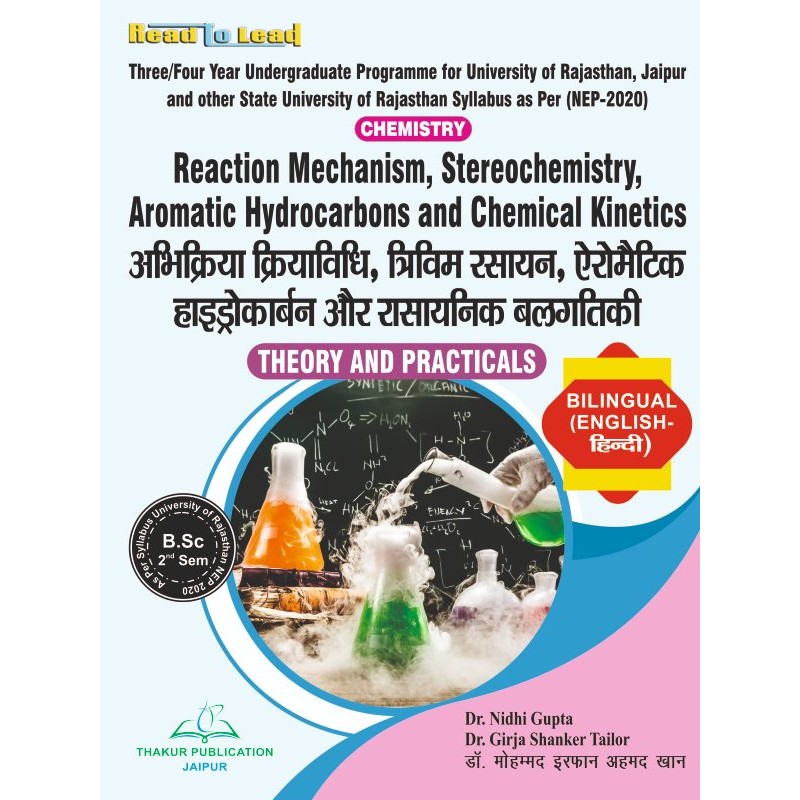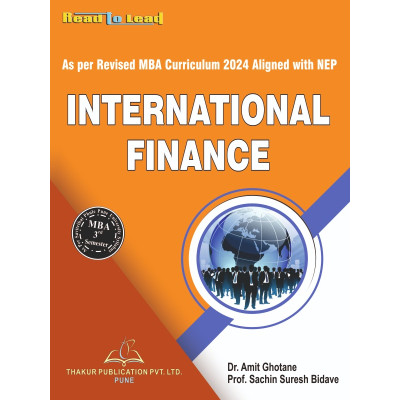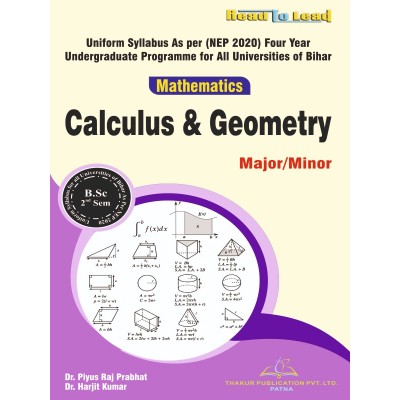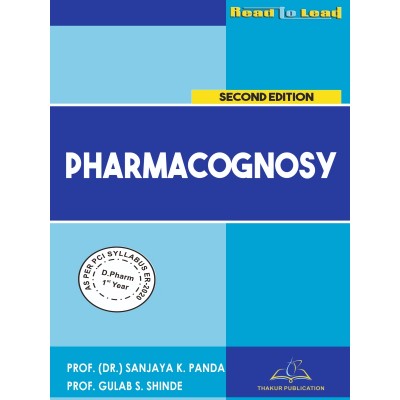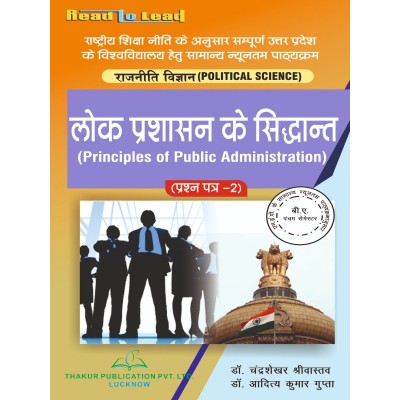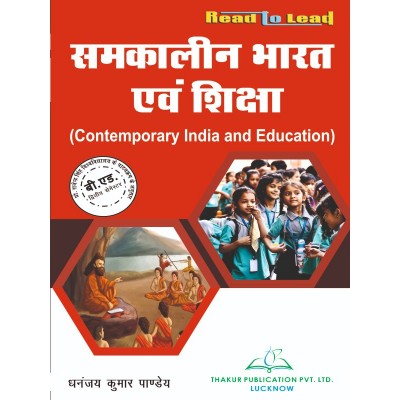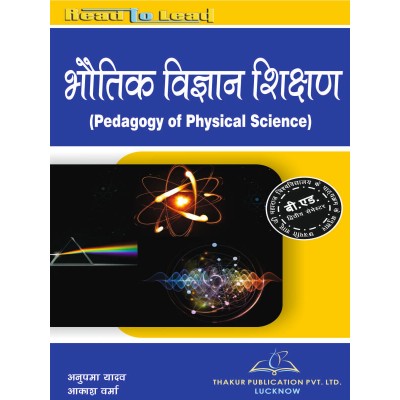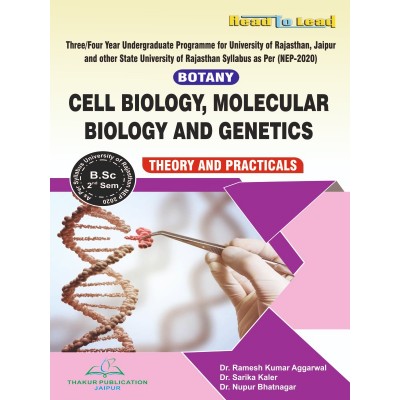(Chemistry) Reaction Mechanism,Stereochemistry,Aromatic Hydrocarbons and Chemical Kinetics B.Sc 2nd Sem UOR
Tax excluded
Click below to Buy E-Book Edition:
Buy Latest (Chemistry) Reaction Mechanism,Stereochemistry,Aromatic Hydrocarbons and Chemical Kinetics Book in Bilingual Edition ( Both English and Hindi ) for B.Sc 2nd Semester University of Rajasthan, Jaipur NEP-2020 By Thakur Publication
AUTHORS: Dr. Nidhi Gupta , Dr. Girja Shanker Tailor , Dr. Mohmad Erfan Ahmad khan
ISBN : 978-93-5755-722-1
Syllabus ¼ikB~;Øe½
Chemistry: Reaction Mechanism, Stereochemistry, Aromatic
Hydrocarbons and Chemical Kinetics ¼jlk;u foKku vfHkfØ;k fØ;kfof/k] f=foe jlk;u] ,sjkseSfVd gkbMªksdkcZu vkSj jklk;fud cyxfrdh½
|
Unit |
Topics |
No. of Lectures |
|
|
1 |
Introductory Concept and Mechanism of Organic Reactions: IUPAC nomenclature of organic compounds, Dipole moment, Inductive and field effects, electromeric effect, conjugation, resonance and resonance energy, hyper-conjugation. Homolytic and heterolytic bond cleavage. Type of reagents, electrophiles and nucleophiles. Reactive intermediates-carbocations, carbanions, free radicals, carbenes, arynes and nitrenes (generation, reactions and stability).
Types of organic reactions. Markovnikov’s rule, Anti-Markovnikov’s rule, Saytzeff’s rule and Hofmann elimination. Energy considerations. Methods of determination of reaction mechanism (product analysis, intermediates, isotope labelling, kinetic and stereochemical studies), isotope effects.
|
dkcZfud vfHkfØ;kvksa dh ifjp;kRed vo/kkj.kk vkSj fØ;kfof/k& dkcZfud ;kSfxdksa dk IUPAC ukedj.k] f}/kzqo vk?kw.kZ] çsjd vkSj {ks= çHkko] bysDVªksesfjd çHkko] la;qXeu] vuqukn vkSj vuqukn ÅtkZ] vfrla;qXeuA gkseksfyfVd vkSj gsVsjksfyfVd ca/k fonyuA vfHkdeZdksa] bysDVªksQkby vkSj U;wfDy;ksQkby ds çdkjA
vfHkfØ;k'khy e/;orhZ& dkcZ/kuk;u] dkcZ_.kk;u] eqDr ewyd] dkchZu] ,sjhu vkSj ukbVªhu ¼mRiknu] vfHkfØ;k vkSj fLFkjrk½A dkcZfud vfHkfØ;kvksa ds çdkj- ekdksZfudksQ fu;e] ,aVh&ekdksZfudksQ fu;e] lSVtsQ fu;e vkSj g‚QeSu foyksiuA ÅtkZ laca/kh fopkj- vfHkfØ;k fØ;kfof/k ¼mRikn fo'ys"k.k] e/;orhZ] leLFkkfud yscfyax] xfrt vkSj f=foejklk;fud v/;;u½] leLFkkfud çHkko ds fu/kkZj.k dh fof/kA |
15 |
|
2 |
Stereochemistry of Organic Compounds: Concept of isomerism, Types of isomerism, Difference between configuration and conformation, Flying wedge and Fischer projection formulae.
Optical Isomerism: Elements of symmetry, molecular chirality, enantiomers, stereogenic centre, optical activity. Properties of enantiomers, chiral and achiral molecules with two stereogenic centres. Diastereomers, threo and erythro isomers, meso compounds. Resolution of enantiomers. Inversion, retention and racemization (with examples). Relative and absolute configuration, sequence rules, D/L and R/S systems of nomenclature.
Geometrical Isomerism: Determination of configuration of geometric isomers-cis/trans and E/Z systems of nomenclature. Geometrical isomerism in oximes and alicyclic compounds.
Conformational Isomerism: Newman projection and Sawhorse formulae, Conformational analysis of ethane, n-butane and cyclohexane. |
dkcZfud ;kSfxdksa dh f=foe jlk;u& leko;ork dh vo/kkj.kk] leko;ork ds çdkj] foU;kl vkSj lajpuk ds chp varj] ¶ykbax ost vkSj fQ'kj ç{ksi.k lw=A
Ádkf’kd leko;ork & rRoksa dh lefefr] vk.kfod fdjsyrk] çfrfcac :ih leko;o] LVhfj;kstsfud dsUæ] izdkf’kd lfØ;rkA nks LVhfj;kstsfud dsaæksa ds lkFk ÁfrfcEc :ih leko;o] fdjsy vkSj vfdjsy v.kqvksa ds xq.kA vçfrfcach f=foe leko;o] Fkzsvks vkSj ,fjFkzks leko;o] eslks ;kSfxdA çfrfcac :ih leko;o dk fo’ys"k.kA izfrykseu] vojks/ku vkSj jSflfedhdj.k ¼mnkgj.k ds lkFk½A lkis{k vkSj fujis{k foU;kl] vuqØe fu;e] ukedj.k dh D/L vkSj R/S i)frA
T;kferh; leko;ork& ukedj.k dh T;kferh; leko;o&fll/Vªkal vkSj E/Z i)fr;ksa ds foU;kl dk fu/kkZj.kA v‚fDlEl vkSj ,sfylkbfDyd ;kSfxdksa esa T;kferh; leko;orkA la#ih; leko;ork& U;weSu ç{ksi.k vkSj l‚g‚lZ lw=] ,Fksu] n-C;wVsu vkSj lkbDyksgsDlsu dk la#ih; fo'ys"k.kA |
15 |
|
3 |
Arenes and Aromaticity: Nomenclature of benzene derivatives. The aryl group, aromatic nucleus and side chain. Structure of benzene: molecular formula and Kekule structure. Stability and carbon-carbon bond lengths of benzene, resonance structure, MO’diagram.
Aromaticity: Huckel rule, aromatic ions-three to eight membered.
Aromatic Electrophilic Substitution: General pattern of the mechanism, role of sigma and pi complexes. Mechanism of nitration, halogenation, sulphonation, mercuration, chloromethylation and Friedel Crafts reactions. Energy profile diagrams. Activating and deactivating substituents. Directive influence orientation and ortho/para ratio. Side chain reactions of benzene derivatives. Birch reduction. |
,sjhu vkSj ,jkseSfVdrk& csathu O;qRiUu dk ukedj.kA ,sfjy lewg] ,sjkseSfVd ukfHkd vkSj ik'oZ J`a[kykA csathu dh lajpuk& vk.kfod lw= vkSj dsdqys lajpukA csathu dh fLFkjrk vkSj dkcZu&dkcZu ca/k dh yackbZ] vuqukn lajpuk] MO vkjs[kA
,sjkseSfVdrk& gdy fu;e] ,sjkseSfVd vk;u&rhu ls vkB lnL;h;A
,sjkseSfVd bysDVªkLusgh çfrLFkkiu& fØ;kfof/k dk lkekU; iSVuZ] flXek vkSj ikbZ ladqy dh HkwfedkA ukbVªhdj.k] gSykstuhdj.k] lYQksuhdj.k] eD;Zwjs'ku] DyksjksesfFkyhdj.k vkSj ÝhMsy Øk¶V~l vfHkfØ;kvksa dh fØ;kfof/kA ÅtkZ çksQkby vkjs[k- çfrLFkkfi;ksa dks lfØ; vkSj fuf"Ø; djukA funsZ'kkRed çHkko vfHkfoU;kl vkSj v‚FkksZ/iSjk vuqikrA csathu O;qRiUu dh ik’oZ J`a[kyk vfHkfØ;k,aA cpZ vip;u |
15 |
|
4 |
Chemical Kinetics: Chemical kinetics and its scope, rate of a reaction, factors influencing the rate of a reaction: concentration, temperature, pressure, solvent, light, catalyst.
Concentration dependence of rates, mathematical characteristics of simple chemical reactions – zero order, first order, second order and pseudo-order; half-life and mean-life. Determination of the order of reaction differential method, method of integration, method of half-life period and isolation method.
Radioactive decay as a first order phenomenon.
Experimental Methods of Chemical Kinetics: Conductometric, potentiometric, optical methods, (polarimetry) and spectrophotometric method. Theories of chemical kinetics. Effect of temperature on rate of reaction, Arrhenius equation, concept of activation energy.
Simple collision theory based on hard sphere model transition state theory (equilibrium hypothesis). Expression for the rate constant bases on equilibrium constant and thermodynamic |
jklk;fud cyxfrdh& jklk;fud cyxfrdh vkSj mldk dk;Z{ks=] vfHkfØ;k dh nj] vfHkfØ;k dh nj dks çHkkfor djus okys dkjd& lkanzrk] rkieku] nkc] foyk;d] çdk'k] mRçsjdA
njksa dh lkanzrk fuHkZjrk] ljy jklk;fud vfHkfØ;kvksa dh xf.krh; vfHky{k.k & 'kwU; dksfV] izFke dksfV] f}rh; dksfV vkSj Nn~e dksfV] v/kZ vk;q vkSj vkSlr vk;qA vfHkfØ;k dh dksfV dk fu/kkZj.k foHksnd fof/k] ,dhdj.k dh fof/k] v)Z&vk;q dky dh fof/k vkSj i`Fkddj.k fof/kA
çFke dksfV dh ?kVuk ds :i esa jsfM;ks/kehZ {k;A
jklk;fud cyxfrdh dh çk;ksfxd fof/k;k¡& pkydrkekih] foHkoekih] izdkf’kd fof/k;k¡] ¼/kzqo.kfefr½ vkSj LisDVªksQksVksesfVªd fof/kA jklk;fud cyxfrdh ds fl)kar- vfHkfØ;k dh nj ij rkieku dk çHkko] vkjgsfu;l lehdj.k] lfØ;.k ÅtkZ dh vo/kkj.kkA
dBksj xksyk e‚My laØe.k voLFkk fl)kar ¼lkE; ifjdYiuk½ ij vk/kkfjr ljy Vdjko fl)karA lkE; fLFkjkad vkSj Å"ek xfrdh ij nj fLFkj {kkjksa dk O;atdA |
15 |
Practical ¼ç;ksxkRed½
|
Inorganic Chemistry Volumetric Analysis 1) Determination of acetic acid in commercial vinegar using NaOH. 2) Determination of alkali content in antacid tablet using HCl. 3) Estimation of calcium content in chalk as calcium oxalate by permanganometery. 4) Estimation of hardness of water by EDTA. 5) Estimation of ferrous and ferric by dichromate/permanganate method. 6) Estimation of copper using thiosulphate by iodometric method.
Organic Chemistry Qualitative Analysis Identification of organic compound through the functional group analysis, determination of melting point, boiling point and specific test.
Physical Chemistry Chemical Kinetics 1) To determine the specific reaction rate of the hydrolysis of methyl acetate/ ethyl acetate catalysed by hydrogen ions at room temperature. 2) To study the effect of acid strength on the hydrolysis of an ester. 3) To compare the strengths of HCl and H2SO4 by studying the kinetics of hydrolysis of ethyl acetate. 4) To study kinetically the reaction rate of decomposition of iodide by H2O2. |
vdkcZfud jlk;u foKku vk;rufefr fo'ys"k.k 1) NaOH dk mi;ksx djds O;kolkf;d fljds esa ,lhfVd vEy dk fu/kkZj.kA 2) HCl dk mi;ksx djds ,aVkflM VScysV esa {kkj lkexzh dk fu/kkZj.kA 3) ijeSaxuksesVªh }kjk pkd esa dSfY'k;e v‚DtsysV ds :i esa dSfY'k;e lkexzh dk vuqekuA 4) EDTA }kjk ty dh dBksjrk dk vuqekuA 5) MkbØksesV/ijeSaxusV fof/k }kjk Qsjl vkSj Qsfjd dk vk¡dyuA 6) vk;ksMksesfVªd fof/k }kjk Fkk;kslYQsV dk mi;ksx djds dkWij dk vuqekuA
dkcZfud jlk;u xq.kkRed fo'ys"k.k fØ;kRed lewg fo'ys"k.k ds ek/;e ls dkcZfud ;kSfxd dh igpku] xyukad] DoFkukad vkSj fof'k"V ijh{k.k dk fu/kkZj.kA
HkkSfrd jlk;u] jklk;fud cyxfrdh 1) dejs ds rkieku ij gkbMªkstu vk;uksa }kjk mRçsfjr esfFky ,lhVsV/,fFky ,lhVsV ds tyvi?kVu dh fof'k"V vfHkfØ;k nj fu/kkZfjr djus ds fy,A 2) ,LVj ds tyvi?kVu ij vEy lkanzrk ds çHkko dk v/;;u djukA 3) ,fFky ,lhVsV ds tyvi?kVu dh xfr'khyrk dk v/;;u djds HCl vkSj H2SO4 dh lkanzrk dh rqyuk djukA 4) H2O2 }kjk vk;ksMkbM ds vi?kVu dh vfHkfØ;k nj dk cyxfrdh :i ls v/;;u djukA |







